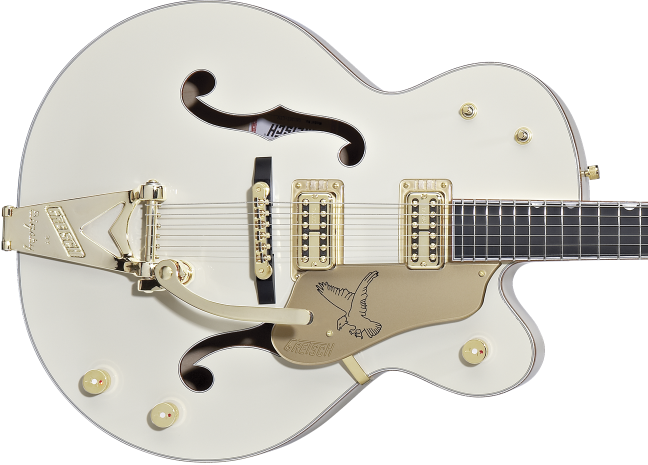Review: Gretsch G6136T-LTV White Falcon — Video

PLATINUM AWARD
The Gretsch White Falcon was designed primarily by Jimmie Webster, a jazz guitarist who worked closely with Gretsch during the Fifties.
Introduced in 1954, the guitar was initially supposed to be a concept model that was described as a “dream guitar of the future.” However, dealer demand for the model was so high that the White Falcon went into production a few months later in 1955.
Originally designed to appease the sophisticated tastes of jazz players and promoted as the “Cadillac of guitars,” the White Falcon also attracted a small but dedicated legion of hillbilly hipsters and country cool cats during the Fifties.
However, a number of high-profile rockers like Neil Young, Stephen Stills, Sylvain Sylvain (with the New York Dolls), Billy Duffy, and James Hetfield made the White Falcon into a lusted-after rock and roll machine during the Seventies and beyond. I even fondly remember seeing Malcolm Young grappling with a huge White Falcon like a toddler wrestling a pig during a late-Seventies AC/DC concert.
Today Gretsch offers a dozen Falcon models, including versions with black or green finishes. Each is cool in its own way, but my personal favorite is the new G6136T-LTV White Falcon. Based upon the late Fifties version, the G6136T-LTV includes a few modern updates that makes possibly the best White Falcon ever.
FEATURES
The White Falcon has always been a big, bruising beast of a guitar, and the G6136T-LTV is no exception. It has the same classic design features—a massive 17-inch body, 2 3/4–inch body depth, 25 1/2–inch scale, maple neck, and laminated body construction that make it both big and somewhat heavy. The cosmetics come from the coveted 1958-60 era and include an ebony fingerboard with Neo-Classic “thumbnail” inlays, gold sparkle and multi-layer black and white binding, a square model ID plate on the headstock, horizontal gold sparkle Gretsch headstock logo, jeweled arrow control knobs, oversized bound f-holes, a V-cutout gold-plated Bigsby B6G vibrato, floating gold plexi pickguard with engraved falcon (actually an eagle) motif, aged white nitrocellulose lacquer finish, and gold-plated Grover Imperial tuners with stairstep buttons.
New improvements include an Adjusto-Matic bridge that is pinned into place and a pair of TV Jones TV Classic humbucking pickups, which are based on the highly desirable PAF Filter’tron pickups of the late Fifties. While the G6136T-LTV provides the same three-position pickup selector switch, individual volume controls for each pickup, and master volume control, the circuitry of the three-position tone switch is a little more user friendly than the vintage version, which basically offered one usable setting and two settings of ponderous mud. The 22 medium-jumbo frets are also a better match for the preferences of modern guitarists.
PERFORMANCE
With the exception of the Duo-Jet, I think that the White Falcon is Gretsch’s most rocking guitar design—not just for how it looks but, more importantly, for how it sounds. With a longer scale than other Gretsch models, the White Falcon delivers much tighter bass and a distinctive percussive twang that transforms to a delicious crunch with overdrive and distortion.
The TV Classic pickups have a tasty midrange honk and relatively low output, which maintains clarity, attack, and note-to-note definition now matter how high the gain. The end result is one of the best rock rhythm guitar sounds you’ll ever hear—no wonder Malcolm Young is a fan of the White Falcon as well as his trusty Jet Firebird. This bird growls more than it twangs, and the harder you push it the sharper its teeth and bite become.
Most Gretsch production models, including this one, are made in Japan, and frankly the construction and attention to detail puts even the most beloved original vintage examples to shame. The guitar feels very solid in the hands, and the playability is simply sublime thanks to the shallow C-shaped profile. The nitrocellulose lacquer finish is lightly applied so the top vibrates responsively, but not too much, which helps keep feedback under control when amplified. Its unplugged tone is already bold and assertive, and those qualities only get better when you plug it in and let ’er rip.
LIST PRICE $5,399
MANUFACTURER Gretsch Guitars, gretschguitars.com
•A pair of TV Jones TV Classic humbucking pickups provides the coveted tones and performance of late-Fifties PAF Filter’Trons.
•Modern upgrades include a pinned Adjusto-Matic bridge that stays in place when the strings are removed and medium-jumbo frets.
•The 25 1/2–inch scale delivers tighter bass and more aggressive twang than other Gretsch hollowbody models.
•Cosmetics come from the 1958–60 era White Falcon and include Neo Classic “thumbnail” inlays, jeweled arrow controls knobs, and oversized bound f-holes.
THE BOTTOM LINE With its just-right balance of classic aesthetics and modern upgrades, the Gretsch G6136T-LTV is by far the best White Falcon model that the company currently offers, particularly for rock-minded players.
Get The Pick Newsletter
All the latest guitar news, interviews, lessons, reviews, deals and more, direct to your inbox!
Chris is the co-author of Eruption - Conversations with Eddie Van Halen. He is a 40-year music industry veteran who started at Boardwalk Entertainment (Joan Jett, Night Ranger) and Roland US before becoming a guitar journalist in 1991. He has interviewed more than 600 artists, written more than 1,400 product reviews and contributed to Jeff Beck’s Beck 01: Hot Rods and Rock & Roll and Eric Clapton’s Six String Stories.
“What blew me away was that everyone wanted the curly maple top. People were calling, saying, ‘I’ve got to have the bird inlays’”: Paul Reed Smith on raising the Standard 24, finally cracking the noise-free guitar and why John Sykes is a tone hero
“It combines unique aesthetics with modern playability and impressive tone, creating a Firebird unlike any I’ve had the pleasure of playing before”: Gibson Firebird Platypus review

